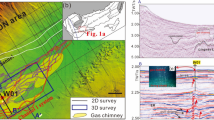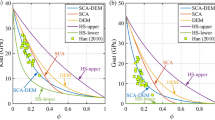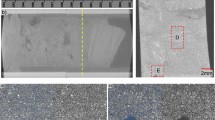Abstract
Laboratory visual detection on the hydrate accumulation process provides an effective and low-cost method to uncover hydrate accumulation mechanisms in nature. However, the spatial hydrate distribution and its dynamic evolutionary behaviors are still not fully understood due to the lack of methods and experimental systems. Toward this goal, we built a two-dimensional electrical resistivity tomography (ERT) apparatus capable of measuring spatial and temporal characteristics of hydrate-bearing porous media. Beach sand (0.05–0.85 mm) was used to form artificial methane hydrate-bearing sediment. The experiments were conducted at 1°C under excess water conditions and the ERT data were acquired and analyzed. This study demonstrates the utility of the ERT method for hydrate mapping in laboratory-scale. The results indicate that the average electrical conductivity decreases nonlinearly with the formation of the hydrate. At some special time-intervals, the average conductivity fluctuates within a certain scope. The plane conductivity fields evolve heterogeneously and the local preferential hydrate-forming positions alternate throughout the experimental duration. We speculate that the combination of hydrate formation itself and salt-removal effect plays a dominant role in the spatial and temporal hydrate distribution, as well as geophysical parameters changing behaviors during hydrate accumulation.
Similar content being viewed by others
References
Asgarifar S, Frounchi J, Zarifi M H, et al. 2010. A novel two-stage genetic algorithm for image reconstruction of electrical resistance tomography. International Journal of Modeling, Simulation, and Scientific Computing, 1(4): 523–542
Attias E, Amalokwu K, Watts M, et al. 2020. Gas hydrate quantification at a pockmark offshore Norway from joint effective medium modelling of resistivity and seismic velocity. Marine and Petroleum Geology, 113: 104151, doi: https://doi.org/10.1016/j.marpetgeo.2019.104151
Bolton G T, Bennett M, Wang Mi, et al. 2007. Development of an electrical tomographic system for operation in a remote, acidic and radioactive environment. Chemical Engineering Journal, 130(2–3): 165–169, doi: https://doi.org/10.1016/j.cej.2006.06.019
Chaouachi M, Falenty A, Sell K, et al. 2015. Microstructural evolution of gas hydrates in sedimentary matrices observed with synchrotron X-ray computed tomographic microscopy. Geochemistry, Geophysics, Geosystems, 16(6): 1711–1722
Chen Qiang, Diao Shaobo, Ye Yuguang. 2013. Detecting hydrate in porous media using electrical resistance. In: Ye Yuguang, Liu Changling, eds. Natural Gas Hydrates: Experimental Techniques and Their Applications. Berlin, Heidelberg: Springer, 127–140
Chen Qiang, Liu Changling, Xing Lanchang, et al. 2016. Resistivity variation during hydrate formation in vertical inhomogeneous distribution system of pore water. Acta Petrolei Sinica, 37(2): 222–229
Chen Yufeng, Wu Nengyou, Liang Deqing, et al. 2018. Numerical simulation on the resistivity of hydrate-bearing sediment based on fractal pore model. Natural Gas Industry, 38(11): 128–134
Chong Zhengrong, Yang She Hern Bryan, Babu P, et al. 2016. Review of natural gas hydrates as an energy resource: prospects and challenges. Applied Energy, 162: 1633–1652, doi: https://doi.org/10.1016/j.apenergy.2014.12.061
Cook A E, Waite W F. 2018. Archie’s saturation exponent for natural gas hydrate in coarse-grained reservoirs. Journal of Geophysical Research: Solid Earth, 123(3): 2069–2089, doi: https://doi.org/10.1002/2017JB015138
Cui Yudong, Lu Cheng, Wu Mingtao, et al. 2018. Review of exploration and production technology of natural gas hydrate. Advances in Geo-Energy Research, 2(1): 53–62, doi: https://doi.org/10.26804/ager.2018.01.05
Cui Ziqiang, Wang Qi, Xue Qian, et al. 2016. A review on image reconstruction algorithms for electrical capacitance/resistance tomography. Sensor Review, 36(4): 429–445, doi: https://doi.org/10.1108/SR-01-2016-0027
Dong Lin, Li Yanlong, Liao Hualin, et al. 2020. Strength estimation for hydrate-bearing sediments based on triaxial shearing tests. Journal of Petroleum Science and Engineering, 184: 106478, doi: https://doi.org/10.1016/j.petrol.2019.106478
Dong Huaimin, Sun Jianmeng, Zhu Jinjiang, et al. 2019. Developing a new hydrate saturation calculation model for hydrate-bearing sediments. Fuel, 248: 27–37, doi: https://doi.org/10.1016/j.fuel.2019.03.038
Du Frane W L, Stern L A, Constable S, et al. 2015. Electrical properties of methane hydrate + sediment mixtures. Journal of Geophysical Research: Solid Earth, 120(7): 4773–4783, doi: https://doi.org/10.1002/2015JB011940
Du Frane W L, Stern L A, Weitemeyer K A, et al. 2011. Electrical properties of polycrystalline methane hydrate. Geophysical Research Letters, 38(9): L09313
Fu Chao, Li Shengli, Yu Xinghe, et al. 2019. Patterns of gas hydrate accumulation in mass transport deposits related to canyon activity: example from Shenhu drilling area in the South China Sea. Acta Oceanologica Sinica, 38(5): 118–128, doi: https://doi.org/10.1007/s13131-019-1443-1
Harinarayana T, Hardage B, Orange A. 2012. Controlled-source marine electromagnetic 2-D modeling gas hydrate studies. Marine Geophysical Research, 33(3): 239–250, doi: https://doi.org/10.1007/s11001-012-9159-z
Heeschen K, Spangenberg E, Schicks J M, et al. 2014. Simulating the gas hydrate production test at Mallik using the pilot scale pressure reservoir LARS. In: EGU General Assembly Conference Abstracts. Vienna: EGU
Jana S, Ojha M, Sain K, et al. 2017. An approach to estimate gas hydrate saturation from 3-D heterogeneous resistivity model: a study from Krishna-Godavari basin, Eastern Indian offshore. Marine and Petroleum Geology, 79: 99–107, doi: https://doi.org/10.1016/j.marpetgeo.2016.11.006
Koh C A, Sum A K, Sloan E D. 2012. State of the art: natural gas hydrates as a natural resource. Journal of Natural Gas Science and Engineering, 8: 132–138, doi: https://doi.org/10.1016/j.jngse.2012.01.005
Konno Y, Kato A, Yoneda J, et al. 2019. Numerical analysis of gas production potential from a gas-hydrate reservoir at Site NGHP-02–16, the Krishna—Godavari Basin, offshore India—Feasibility of depressurization method for ultra-deepwater environment. Marine and Petroleum Geology, 108: 731–740, doi: https://doi.org/10.1016/j.marpetgeo.2018.08.001
Kotzé R, Adler A, Sutherland A, et al. 2019. Evaluation of Electrical Resistance Tomography imaging algorithms to monitor settling slurry pipe flow. Flow Measurement and Instrumentation, 68: 101572, doi: https://doi.org/10.1016/j.flowmeasinst.2019.101572
Li Yanlong, Chen Qiang, Wu Nengyou, et al. 2020a. Core-scale application of electrical resistivity tomography technology on visual detection of natural gas hydrate. Geological Review, 66(S1): 84–86
Li Yanlong, Hu Gaowei, Wu Nengyou, et al. 2019a. Undrained shear strength evaluation for hydrate-bearing sediment overlying strata in the Shenhu area, northern South China Sea. Acta Oceanologica Sinica, 38(3): 114–123, doi: https://doi.org/10.1007/s13131-019-1404-8
Li Chengfeng, Liu Changling, Hu Gaowei, et al. 2019b. Investigation on the multiparameter of hydrate-bearing sands using nano-focus X-ray computed tomography. Journal of Geophysical Research:Solid Earth, 124(3): 2286–2296, doi: https://doi.org/10.1029/2018JB015849
Li Yanlong, Liu Lele, Jin Yurong, et al. 2021. Characterization and development of natural gas hydrate in marine clayey-silt reservoirs: a review and discussion. Advances in Geo-Energy Research, 5(1): 75–86, doi: https://doi.org/10.46690/ager.2021.01.08
Li Yanlong, Liu Changling, Liu Lele, et al. 2018. Experimental study on evolution behaviors of triaxial-shearing parameters for hydrate-bearing intermediate fine sediment. Advances in Geo-Energy Research, 2(1): 43–52, doi: https://doi.org/10.26804/ager.2018.01.04
Li Yanlong, Ning Fulong, Wu Nengyou, et al. 2020b. Protocol for sand control screen design of production wells for clayey silt hydrate reservoirs: a case study. Energy Science & Engineering, 8(5): 1438–1449
Li Yanlong, Sun Hailiang, Liu Changling, et al. 2020c. Application of ERT to hydrate monitoring: take ice as substitute. Marine Geology Frontiers, 36(3): 65–71
Li Yanlong, Sun Hailiang, Meng Qingguo, et al. 2019c. 2-D electrical resistivity tomography assessment of hydrate formation in sandy sediments. Natural Gas Industry, 39(10): 132–138
Li Yanlong, Sun Hailiang, Meng Qingguo, et al. 2020d. 2-D electrical resistivity tomography assessment of hydrate formation in sandy sediments. Natural Gas Industry B, 7(3): 278–284, doi: https://doi.org/10.1016/j.ngib.2019.10.010
Li Yanlong, Wu Nengyou, Ning Fulong, et al. 2020e. Hydrate-induced clogging of sand-control screen and its implication on hydrate production operation. Energy, 206: 118030, doi: https://doi.org/10.1016/j.energy.2020.118030
Liao Jing, Gong Jianming, Lü Wanjun, et al. 2016. Simulation of the accumulation process of biogenic gas hydrates in the Shenhu area of northern South China Sea. Acta Geologica Sinica (English Edition), 90(6): 2285–2286, doi: https://doi.org/10.1111/1755-6724.13048
Lim D, Ro H, Seo Y J, et al. 2017. Electrical resistivity measurements of methane hydrate during N2/CO2 gas exchange. Energy & Fuels, 31(1): 708–713
Liu Changling, Li Yanlong, Liu Lele, et al. 2020a. An integrated experimental system for gas hydrate drilling and production and a preliminary experiment of the depressurization method. Natural Gas Industry B, 7(1): 56–63, doi: https://doi.org/10.1016/j.ngib.2019.06.003
Liu Changling, Li Yanlong, Sun Jianye, et al. 2017. Gas hydrate production test: from experimental simulation to field practice. Marine Geology & Quaternary Geology, 37(5): 12–26
Liu Tao, Liu Xuewei, Zhu Tieyuan. 2020b. Joint analysis of P-wave velocity and resistivity for morphology identification and quantification of gas hydrate. Marine and Petroleum Geology, 112: 104036, doi: https://doi.org/10.1016/j.marpetgeo.2019.104036
Liu Yang, Xian Chenggang, Li Zhe, et al. 2020c. A new classification system of lithic-rich tight sandstone and its application to diagnosis high-quality reservoirs. Advances in Geo-Energy Research, 4(3): 286–295, doi: https://doi.org/10.46690/ager.2020.03.06
Lu R, Stern L A, Du Frane W L, et al. 2019. The effect of brine on the electrical properties of methane hydrate. Journal of Geophysical Research: Solid Earth, 124(11): 10877–10892, doi: https://doi.org/10.1029/2019JB018364
Malinverno A, Kastner M, Torres M E, et al. 2008. Gas hydrate occurrence from pore water chlorinity and downhole logs in a transect across the northern Cascadia margin (Integrated Ocean Drilling Program Expedition 311). Journal of Geophysical Research: Solid Earth, 113(B8): B08103
McConnell D R, Zhang Zijian, Boswell R. 2012. Review of progress in evaluating gas hydrate drilling hazards. Marine and Petroleum Geology, 34(1): 209–223, doi: https://doi.org/10.1016/j.marpetgeo.2012.02.010
Merey Ş. 2019. Evaluation of drilling parameters in gas hydrate exploration wells. Journal of Petroleum Science and Engineering, 172: 855–877, doi: https://doi.org/10.1016/j.petrol.2018.08.079
Pan Haojie, Li Hongbing, Chen Jingyi, et al. 2020. Quantification of gas hydrate saturation and morphology based on a generalized effective medium model. Marine and Petroleum Geology, 113: 104166, doi: https://doi.org/10.1016/j.marpetgeo.2019.104166
Pandey L, Sain K, Joshi A K. 2019. Estimate of gas hydrate saturations in the Krishna-Godavari basin, eastern continental margin of India, results of expedition NGHP-02. Marine and Petroleum Geology, 108: 581–594, doi: https://doi.org/10.1016/j.marpetgeo.2018.12.009
Pearson C F, Halleck P M, McGuire P L, et al. 1983. Natural gas hydrate deposits: a review of in situ properties. The Journal of Physical Chemistry, 87(21): 4180–4185, doi: https://doi.org/10.1021/j100244a041
Permyakov M E, Manchenko N A, Duchkov A D, et al. 2017. Laboratory modeling and measurement of the electrical resistivity of hydrate-bearing sand samples. Russian Geology and Geophysics, 58(5): 642–649, doi: https://doi.org/10.1016/j.rgg.2017.04.005
Priegnitz M, Thaler J, Spangenberg E, et al. 2013. A cylindrical electrical resistivity tomography array for three-dimensional monitoring of hydrate formation and dissociation. Review of Scientific Instruments, 84(10): 104502, doi: https://doi.org/10.1063/1.4825372
Priegnitz M, Thaler J, Spangenberg E, et al. 2014. Spatial resolution of gas hydrate and permeability changes from ERT data in LARS simulating the Mallik gas hydrate production test. In: EGU General Assembly Conference. Vienna: EGU
Priegnitz M, Thaler J, Spangenberg E, et al. 2015. Characterizing electrical properties and permeability changes of hydrate bearing sediments using ERT data. Geophysical Journal International, 202(3): 1599–1612, doi: https://doi.org/10.1093/gji/ggv245
Sahoo S K, Marín-Moreno H, North L J, et al. 2018. Presence and consequences of coexisting methane gas with hydrate under two phase water-hydrate stability conditions. Journal of Geophysical Research: Solid Earth, 123(5): 3377–3390, doi: https://doi.org/10.1029/2018JB015598
Santamarina J C, Ruppel C. 2008. The impact of hydrate saturation on the mechanical, electrical, and thermal properties of hydrate-bearing sand, silts, and clay. In: Proceedings of the 6th International Conference on Gas Hydrates. Vancouver, Canada: Society of Exploration Geophysicists
Shankar U, Riedel M. 2014. Assessment of gas hydrate saturation in marine sediments from resistivity and compressional-wave velocity log measurements in the Mahanadi Basin, India. Marine and Petroleum Geology, 58: 265–277, doi: https://doi.org/10.1016/j.marpetgeo.2013.10.007
Smyl D. 2020. Electrical tomography for characterizing transport properties in cement-based materials: a review. Construction and Building Materials, 244: 118299, doi: https://doi.org/10.1016/j.conbuildmat.2020.118299
Spangenberg E. 2001. Modeling of the influence of gas hydrate content on the electrical properties of porous sediments. Journal of Geophysical Research: Solid Earth, 106(B4): 6535–6548, doi: https://doi.org/10.1029/2000JB900434
Spangenberg E, Kulenkampff J. 2006. Influence of methane hydrate content on electrical sediment properties. Geophysical Research Letters, 33(24): L24315, doi: https://doi.org/10.1029/2006GL028188
Spangenberg E, Kulenkampff J, Naumann R, et al. 2005. Pore space hydrate formation in a glass bead sample from methane dissolved in water. Geophysical Research Letters, 32(24): L24301, doi: https://doi.org/10.1029/2005GL024107
Sun Jianye, Li Chengfeng, Hao Xiluo, et al. 2020. Study of the surface morphology of gas hydrate. Journal of Ocean University of China, 19(2): 331–338, doi: https://doi.org/10.1007/s11802-020-4039-7
Sun Hailiang, Li Yanlong, Liu Changling, et al. 2019. Electrical resistance tomography and the application in the simulation experiment of hydrate mining. Acta Metrologica Sinica, 40(3): 455–461
Waite W F, Santamarina J C, Cortes D D, et al. 2009. Physical properties of hydrate-bearing sediments. Reviews of Geophysics, 47(4): RG4003
Walsh M. 2014. Laboratory and high-pressure flow loop investigation of gas hydrate formation and distribution using electrical tomography. In: Proceedings of the 8th International Conference on Gas Hydrates (ICGH8—2014). Beijing: China Geological Survey
Wang Xiujuan, Wu Shiguo, Lee Myung, et al. 2011. Gas hydrate saturation from acoustic impedance and resistivity logs in the Shenhu area, South China Sea. Marine and Petroleum Geology, 28(9): 1625–1633, doi: https://doi.org/10.1016/j.marpetgeo.2011.07.002
Wu Nengyou, Li Yanlong, Wan Yizhao, et al. 2021. Prospect of marine natural gas hydrate stimulation theory and technology system. Natural Gas Industry B, 8(2): 173–187, doi: https://doi.org/10.1016/j.ngib.2020.08.003
Wu Nengyou, Liu Changling, Hao Xiluo. 2018. Experimental simulations and methods for natural gas hydrate analysis in China. China Geology, 1(1): 61–71, doi: https://doi.org/10.31035/cg2018008
Yang Lei, Falenty A, Chaouachi M, et al. 2016. Synchrotron X-ray computed microtomography study on gas hydrate decomposition in a sedimentary matrix. Geochemistry, Geophysics, Geosystems, 17(9): 3717–3732
Ye Jianliang, Qin Xuwen, Xie Wenwei, et al. 2020. The second natural gas hydrate production test in the South China Sea. China Geology, 3(2): 197–209
Zhang Wei, Liang Jinqiang, Wei Jiangong, et al. 2019. Origin of natural gases and associated gas hydrates in the Shenhu area, northern South China Sea: results from the China gas hydrate drilling expeditions. Journal of Asian Earth Sciences, 183: 103953, doi: https://doi.org/10.1016/j.jseaes.2019.103953
Zhao Jiafei, Liu Yulong, Guo Xianwei, et al. 2020. Gas production behavior from hydrate-bearing fine natural sediments through optimized step-wise depressurization. Applied Energy, 260: 114275, doi: https://doi.org/10.1016/j.apenergy.2019.114275
Funding
The Taishan Scholar Special Experts Project of Shandong Province under contract No. ts201712079; the National Natural Science Foundation of China under contract No. 41976074; the National Key Research and Development Program of China under contract No. 2018YFE0126400.
Author information
Authors and Affiliations
Corresponding authors
Rights and permissions
About this article
Cite this article
Li, Y., Wu, N., Liu, C. et al. Hydrate formation and distribution within unconsolidated sediment: Insights from laboratory electrical resistivity tomography. Acta Oceanol. Sin. 41, 127–136 (2022). https://doi.org/10.1007/s13131-021-1972-2
Received:
Accepted:
Published:
Issue Date:
DOI: https://doi.org/10.1007/s13131-021-1972-2




